

Anna Ptak (Curator and Art Producer)
The Residency Programme Curator
Organising residencies is my daily work. For several years now, I have been involved in collaborating with artists who decide to spend a few months of their lives in Warsaw. As a rule, one of three motives can be attributed to their decision. Some want to engage in a specific artistic activity and an invitation to take part in the A-I-R Laboratory programme corresponds to their search for an institution which will support the accomplishment of their concept in terms of production. Others intend to carry out artistic research, the outcome of which may bear fruit in the emergence of new work. However, a fundamental premise of our programme is that this ‘may’ is indeed ‘may’ and not ‘must’. In these instances, Warsaw’s identified social phenomena, its historical timeline and sui generis collection of relationships which make up the city, as well as its architectural, economic and political fabric, are analysed and mapped, its archives are burrowed into and focused conversations are held with residents and institutions. Then there are those who come to the A-I-R Laboratory in order to reclaim their time; they come in search of a refuge from the pressure of everyday responsibilities and in the hope of a creative experiment.
We A-I-R Laboratory curators act as mediators between the questions and expectations of the artists and the potential offered by our knowledge both of Warsaw itself and of local experts, who may either be researchers or people whose knowledge springs from their daily lives and work in the city. Ultimately, the artists fictionalise and aestheticise the process of seeking and communicating knowledge, subjecting it to artistic interpretation. This element of conceptual artistic practices, which is operating with increasing frequency in the patterns of exhibitions and activities taking place beyond the gallery space, also constitutes a key aspect of the artistic and curatorial work supported by the Warsaw residency centre.

Left: Artists-in-residence of A-I-R Laboratory and employees of the CCA Ujazdowski Castle are planting the seedlings in front of the Laboratory building. Creating the artists’ kitchen garden was part of the project “We Are Like Gardens” (2012) by Juliette Delventhal and Paweł Kruk.
Right: Art workers in their (succesful) attempt to cross the Vistula river in mobile sculpture – amphibian created by Francis Thorburn during his residency at A-I-R Laboratory in 2012.
Photo: Magdalena Starowieyska
The concept of collaboration between the A-I-R Laboratory and Arts Initiative Tokyo (AIT) was born during meetings at a conference held by Res Artis, an international network of residency centres. In itself, the conferences are a specific product of contemporary culture and they serve the ever more efficient mobility of people and their work. Every session saw the gathering of dozens, and sometimes hundreds, of representatives of organisations ranging across the most diverse of models, from small, one-person initiatives to state institutions. The very fact that creative residency centres have come together to found their own unique association and establish a forum which considers them as an autonomous type of institution bears witness to a widespread need. However, despite this common need and efforts at standardisation, the method of designing a programme and the relationships between partner institutions that go hand in hand with that still rely heavily on personal contacts and the building of mutual trust on the basis of shared values which go beyond being mutually rooted in the artistic world and the geopolitical determinants of the level of openness and the potential direction that artistic exchange might take.
Ika Sienkiewicz-Nowacka, the director of A-I-R Laboratory and her counterpart at AIT, Yuko Shiomi, recognised that their programme philosophies have much in common. Both posit a method of running residencies which is individualised and adapted to the needs of the artist. Both encompass a balance between the organisation’s stability in financial and organisational terms on the one hand and efforts to attain a flexible, medium-scale programme on the other. Both view the organisation of a residency as a process of research and experiment in artistic practice, as opposed to aiming at obtaining a finished artistic ‘product’ in exhibition or project form from the venture. Finally, the recognition of a kind of shared generational experience was undoubtedly significant. Both organisations have a history spanning a decade or so, with which the two directors are personally bound up and, in both cases, that period has seen the creation and development of the organisation’s own particular formula for the functioning of artistic residencies.
In the case of Warsaw, it took the form of founding of a unit within the structures of a large, international exhibition centre, the Centre for Contemporary Art Ujazdowski Castle, this being the parent institution of which the A-I-R Laboratory is a branch. In Tokyo, however, the residency organisation was established as a supplementary tool by six curators and organisers with the aim of creating a space for the exchange of ideas, education and critical discourse on contemporary art. In both cases, residencies have become a formula for organising artistic work which both serves as an alternative to exhibition programming and complements it. We are thus intent on introducing and running a series of residencies in this spirit; they will be addressed to Polish and Japanese artists, with the cycle beginning in 2014.
I myself have never taken part in a residency, so the invitation to make a field trip to Arts Initiative Tokyo offered me the chance of discovering what it means and entails. Thus this introduction also aims to outline one of the topics which was of extraordinary importance to my research and investigations. While collaborating with successive generations of artists, I have observed the way in which the process of exchanging knowledge gives rise to shorter- or longer-lived communities and, if the nature of the course of thought, question and answer is mutual education, then this, in fact, occurs by way of those smaller and larger social groupings and not via a linear flow and accretion of knowledge. I was interested in discovering how the artists, curators and organisers interested in the language of conceptual artistic expression organise their institutions in Tokyo and beyond, how they define the public and how they negotiate essential themes with it.
The Curator-in-Residence
What, then, does a curator-in-residence do? Familiarise herself with the artistic practices rooted in the local environment, with the institutions and with the discussions held there. But being a curator-in-residence also means getting lost in the city, quite frequently being late for studio visits, perpetrating gaffes and missing important events, the apology for which is her lack of knowledge of the language. This displacement is also a tool for getting to know the city. In a way, I began my journey around Tokyo from a confrontation with a mirror image of my work in Warsaw; this time, though, I was the one granted the privilege of beginning ‘anew’. Naoko Horiuchi is a curator who looks after artists-in-residence at AIT and she is also one of the people who run its Making Art Different (MAD) programme. MAD is an independent educational initiative which provides evening courses in curatorial studies, art and international art studies. I had the opportunity of meeting Naoko when she visited Warsaw for a few days, which enabled us to sketch out our shared horizon of interests and allowed her to match her recommendations accordingly. Because my residence was not connected with organising a specific exhibition programme or festival, my studio visits and meetings with artists ‘in situ’ were by way of being natural, unconstrained conversations. In conversations of this kind, the meaning of the artist’s work is revealed gradually. The process of communication is both immersed in and an immersion in linguistic complications, the journey, the city… and the meeting place, the difficulties in getting there and in finding the way ahead. My questions and doubts… How much of Tokyo lies underground? How do artists envisage their place in public life? Within the framework of their communities, but also at the level of public debate? Were events as traumatic as the earthquake and tsunami and the ensuing crisis in faith in political guarantees of security followed by reflections on the nature of artistic institutions and practices? How is the emotion of engagement expressed? Concern? Humour? Doubt? Questions which now sound very bald bore the undertone of interest in individual and personal histories of practice.
I have no hesitation in saying that the situation I found myself in thanks to the residency at AIT was a luxury; first and foremost, it was the luxury of changing my relationship with time, my own time. Sometimes, when I tried to arrange a meeting, I would hear that I must certainly be very busy, a polite expression which was intended to inform me of my interlocutor’s respect. Respect for my time, on the one hand and for the many hours worked in the course of day and night; expressing a doubt as to the possibility of meeting which sometimes even seemed to beg for the emerging cultural misunderstanding to be overcome by a denial… no, no, I’m not busy, let’s talk.

One of the rare moments when a rivers shows from the underground in Tokyo.
Photo: Anna Ptak
The Institutional Landscape
I mainly spent my first week on walks which lasted hours, creating my own map of the city; my conbento, my favourite soup, how to go shopping competently. I was also tying up loose Varsovian ends and engaged in slowly establishing a new web of connections between my envisagement of art in Japan and where and how I could discover it. What I absorbed in particular from the initial period of my wanderings were the corporation museums; sometimes memorials to their founders, sometimes constituting a metaphysical fabric for a product created by the company in question. On the one hand, they manifestly reinforce the symbolic message of the brand; on the other hand, they help to nurture a well-disposed attitude toward the items being manufactured. Beautifully laid out, on a smaller scale as a rule, to my mind they are a superb supplement to the massive collections held in public museums. And, as exhibitions related to a specific business, they also reveal a narrative mode, being just as much a story of the objects and of the company’s tradition or a collector’s passion as they are material proof of the two intertwined movements of display and inhibition. The work is done and what remains is a beautiful object, now withdrawn from use; the effort of attainment, the context of use and the multiplicity of social and economic messages leading to the exhibition of the item do not make it as far as the museum showcase.
In the introduction to the Toward a DESIGN MUSEUM JAPAN at 21_21 Design Sight, the organizers make mention of these museums; carpentry, paper and tannery museums, cosmetics and bread factory museums, seeing the nucleus of a grand, future museum of design in them. What I found inspiring was the thinking accompanying the exhibition in terms of the relationship between the history of these places and an aspect of design which concerns not so much the manufacture of objects as the transfer of knowledge about materials which connect widely different groups of people. And the museum-memorials, bound up with a specific moment in the history of a company’s development, are also the history of museum techniques as practised on precarious ground. The one which became my favourite was the Hatakeyama Memorial Museum, which was established by Issey Hatakeyama, the owner of the Ebara Corporation, in 1964. In the exhibition I saw tea utensils reflecting the wabi aesthetic, several travel letters in the form of poetry, scrolls bound in a way which allows them to be displayed stored and transported. I thought about huge filters, perforations and pumps manufactured by Ebara Corporation, though invisible in the exhibition, and imagined them connected to the fragile exhibits by plastic wires like the ones securing them in the glass showcases against less intensive earthquakes. And a place I needed prompting to see; a building in the Japanese international style, set in a garden tucked away between the side streets of Shirokanedai, where a Modernist display system intermingles freely and natural with the traditional architecture of a Japanese house.

Looking for things – Tokyo local neighbourhood map.
Photo: Anna Ptak
In Japan’s institutional landscape, a specific place seems to be occupied by the small urban centres, of which there is an extraordinary number. In these centres, contemporary art is a practice which keeps company with the local community. Many of them are located in Tokyo; however, I also had the opportunity of meeting people running such centres beyond the metropolis. What struck me about them was that, in every case, this ‘companionship’ was not in the least an abstract value, but a real contribution of work on the part of the employees, guest and collaborating artists and the supporting officials and volunteers. I took part in a discussion panel devoted to the financial and political sources of independence for artistic institutions. The discussion was held at Arcus Project, in the city of Moriya in the Ibaraki Prefecture, as an event accompanying the open days in the studios of three international artists-in-residence working in the Arcus Project’s building, a former primary school. Visitors included an entire host of guests from Tokyo; artists, curators and critics alike. However, what was primarily evident was the highly local nature of the event.
Three artists, Rodrigo Gonzalez Castillo, Sybille Neumeyer and Nandesha Shanthi Prakash, were presenting the effects of their three-month residencies. A key aspect of the presentations was the identification of a whole series of moments connected with the transfer of knowledge between the artists and the local people from the city and its environs and its translation by means of various media. Gonzalez Castillo, using simple, analogue printing techniques which were a mixture of his own and those drawn from the rich arsenal of Japanese tradition, carried out a kind of barter, an exchange between the local people supplying the iconography and the artist running the workshops and handing out prints. Neumeyer, in turn, performed a radical and poetic short cut. The emotional impulse of her work was created by an immersive video installation built from a black space imbued with the scent of the earth scattered on the floor and a video screen pulsating to the rhythm of a looped shot of the drying soil prepared under cultivation. The surrounding agricultural fields of Ibaraki on the one hand and the crisis engendered by the radioactive contamination of the soil on the other constituted an unmistakable context for the work. However, between those two poles lay an entire network of contacts and visits made and conversations held; the network wherein the work’s shape and form emerged.
In organisational terms, Arcus is bound up with the local authorities and both sides put in a great deal of work on maintaining that relationship. The fact that the public at the event had the opportunity of recognising themselves in the artists’ work was not some kind of naturally occurring phenomenon, but something which had been worked on and developed. However, what struck me was the openness at the institutional level. During the open days, there was a tour for the youngest school classes. The tour offered the children the chance to see the artistic ‘kitchen’ and not the final product, polished to a fare-thee-well, which appears from who-knows-where in museums. While the event was in progress, I met a local councillor. He turned out to be a local councillor who spent years canvassing for funding to be found for Arcus from the local budget. According to the Councillor, contemporary art makes it possible both to see matters in a light which is sought in vain in reality and to see something new, unlike the rather dull and tame traditional arts. Let me add that he is an engineer and has never officially studied art.
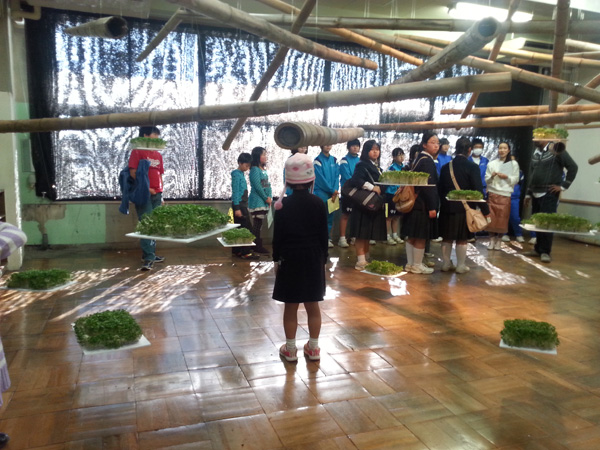
Former classroom – open studio of Nandesha Shanthi Prakash, artist-in-residence in ARCUS in 2013.
Photo: Anna Ptak
The Toride Art Project (TAP) also demonstrates the interesting potential of setting an artistic centre in a specific environment and reality. It, too, is situated beyond the metropolis in what is, by European standards, a massive city in its own right, despite being a Tokyo dormitory town. TAP performs the role of intermediary and organises events which facilitate both contact with art and its exposition. Behind it, it has its location in Tokyo Art University and the students of that seat of learning on the one hand and, on the other, the inhabitants of the urban-rural municipality. The office is run by volunteers and the intitiatives, both formal and informal, which are launched and accomplished either by TAP or in collaboration with it range from the organisation of competitions and making studio space available for artists to projects related to the local character. One such venture is a long-term project, Half-Agriculture, Half-Art, which was initiated by an artist, Iwama Satoshi, as a site for the cultivation and exchange of food, as well as for education on food production. And again, the catastrophe of 2011 gave rise to the necessity of reworking the aims of the project and its method of operating. The new opening took the form of conducting decontamination work on the radioactive soil of rented farmland. At present, the project includes running a market for locally produced food.
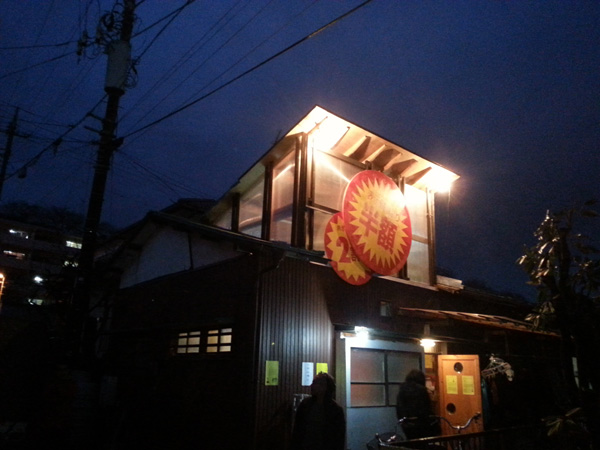
Visiting artists studios and places of initiatives in Toride.
Photo: Anna Ptak
I accidentally came across yet another mechanism for connecting with the surrounding environment and communities in Onomichi, in the Hiroshima Prefecture. I was looking for somewhere to stay in the vicinity of Momoshima, a tiny island in the Seto Inland Sea. The island is also the site of activities carried out by the artists invited every year by Yukinori Yanagi, who has a studio in a now closed primary school. A cold wind was sweeping the island, which had been abandoned by the artists before the onset of winter. As I waited to take the ferry back to Onomichi, I was watching the farmers loading crates of mandarins onto the cutters and the island’s inhabitants who can no longer manage on the income derived from farming descending from the ferry on their way home from work. The tourist season was over and the entire area was revealing its sensitive side; the tough living conditions and isolation on the islands and the iron structures rusting in the water, eloquent industrial relics of endeavours to create an alternative to a way of life grounded in agriculture and fishing.
I stayed in the Anago guesthouse. Its façade, very easily missed in the shopping arcade in which it stands, conceals what was, for me, the extraordinary space of a traditional inn. In the narrow café space at the front, a talk was given, with slides. Amidst the handwritten Japanese notations, incomprehensible to me, I began to recognise places and things familiar to me; an Armenian church on an island in a lake; the shape of a bottle of Ararat brandy, the wilderness of the landscape around Yerevan. It transpired that a lecturer from the local university, an architect by the name of Yoshitaka Watanabe, was giving a presentation on the importance of travel experiences and notes to the architect’s work. It also turned out that the Anago inn is one of several places in Onomichi which, thanks to the commitment of the local residents, has been saved from radical and destructive modernization.
The association of residents engaged in saving traditional Japanese houses draws together a handful of people who run cultural and public activities in restored buildings of that kind. Every year, Hochoul Lee, an artist from Onomichi, invites international artists to AIR Onomichi, which he holds in one such place. Masako Toyota, who owns the Anago, offers a space for cultural events and runs her guesthouse as a venue which is intended to be, and is, a meeting place for the locals and travellers. The kotatsu table, obligatory at that time of year, proved to be as practical a solution as ever, given both the lack of heating in traditional Japanese houses and the conversation I got into with the people whose legs were tucked under the heated blanket-and-table along with mine.
Within the formula of local engagement and revitalisation, the actors work together and guests invited from outside strengthen the collaboration by focusing the group’s interest, concern and curiosity. However, those places and those communities are the bearers of the continuity and memory which is an essential complement and alternative to the propositions of those who are constantly on the move, facilitating a rational use of the energy flowing from artistic experiment. To a certain degree, the places I have described above constitute a traditional model of local organisation, although they clearly demonstrate their openness to the critical practices of contemporary visual and performance art. In turn, the artists do not renounce the social context, often abandoning forms of representing the new reality in favour of engaging in enactment / performance based on the situation of the circulation of cultural forms.

A lecture on travel notes in Anago inn, Onomichi.
Photo: Anna Ptak
Finally, I would like to mention two organisations which, for me, were signposts and inspirations as regards thinking on the practice of correlation. They cannot be compared in terms of making choices as regards relationships with official administration or the scale of their activities. Nonetheless, in my opinion, they constitute important poles for reflection on the traditional place of art presentation. For, rather than the concept of independence, these organisations are focused more on reflecting on the forms of correlation between artistic practices and the social, financial and political backing within which they are accomplished.
One of them, Mediatheque in Sendai, is an institution devoted to the production, storage and presentation of documents, including those of an artistic in nature, the creators of which may be professional authors, groups of people or individuals who apply under a rolling selection process or take part in one of the ongoing documentary cycles run by the Mediatheque team. This extraordinary public library is housed in a six-storey building; designed by Toyo Ito, its fundamental characteristic is transparency. The entire structure has a transparent façade which reflects exterior shapes, forms and colours, changing along with its surroundings.
Before I found myself there, it would have been difficult for me to define the kind of inaccessibility that arises from the architecture of Japanese streets, which conceals whatever the interior holds, irregardless of whether it is a private home, an institution or a bar. In principle, the only open interiors are those of crafts workshops in the older parts of the city and, in this sense, Mediatheque becomes a workshop of that kind, creating a place of access to information and images from its machinery. From the early morning, the building was full of people of very different ages and, importantly, particularly of older people, who are not, as a rule, easy to spot in the noisy, fast-paced public spaces. Hosts of people were availing themselves of the library, but they were also spreading themselves out with their books, chatting to others or simply warming themselves in the winter sun, making themselves comfy on the countless mats and in the equally prolific armchairs, nooks and crannies of the building.
Mediatheque is also a contemporary arts institution to the extent that its archival holdings provide access to documents and works, including artistic ones. It was thanks to this that I had the opportunity of seeing the Dumb Type retrospective and to add the question posed by the group’s art to my own interrogative musings on contemporary forms of crisis… how many forms of love are lost to a society which deems itself a monolith? The media and social archives run by Mediatheque under the direction of Kenji Kai, an experienced creator of independent media, in collaboration with Chinatsu Shimizu, are intended to prevent knowledge of the direct surroundings and the world from being rendered unquestionable. For me, one of Mediatheque’s projects was of enormous importance; the Recorder 311 archive. Available on the Internet and continually being supplemented, it consists of recorded conversations with people from the regions affected by the Tohoku earthquake and tsunami. The material is also presented in English.
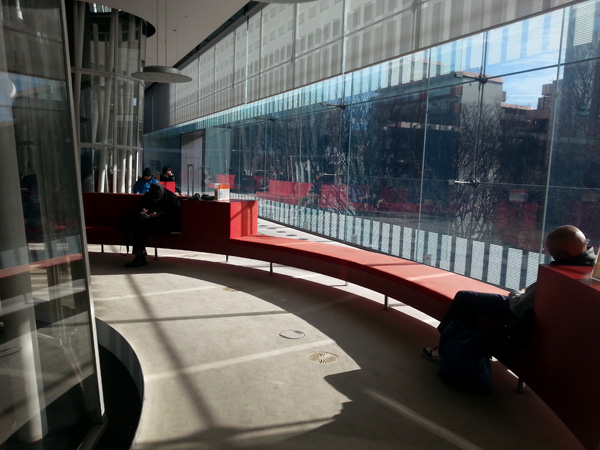
Inside – outside Sendai Mediatheque.
photo: Anna Ptak
In turn, the Hanare x Social Kitchen is a micro organisation and venue established in Kyoto by hanare. It comprises a workplace, a venue for activities, including those of an artistic nature, and a small café offering healthy cuisine and run in accordance with the principles of sustainable food production. The organisation is located in a district of low, single-family homes, in a building squeezed between a temple, a school and the walls of the nearby houses. However, rather than cultivate the idyllic nature of the surroundings and conserve an approach based on pro-ecological consumption, hanaredoes a great deal to introduce the factor of personal engagement into the procedural methods of dealing with art and current socio-political issues, keeping the centre going by means of its own work and activities where consensus is by no means a lodestar.
Social Kitchen is the support base for several initiatives which were inspired by its owners, but it is also open to others who combine within themselves the endeavour to ‘be a better citizen’ and a critical attitude toward reality. So the building has seen meetings of the district committee established to prepare crucial topics for introduction into the debate around the local elections and working groups engaging with the social and political effects of the Great East Japan Earthquake and analysing information on the consequences of the damage to the Fukushima I Nuclear Power Plant which ensued. The work with artists is also process-based and experimental in nature, being carried out under the One Year of Exploration formula, whereby artists are given a space for contact with the public in a rhythm subordinated to their work.
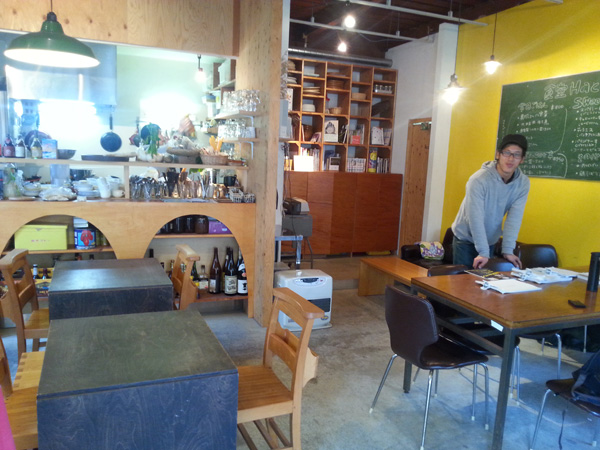
Cafe in hanare x Social Kitchen, Kyoto.
Photo: Anna Ptak
The Curator-Resident
The artistic scene in Tokyo, with its splendid museums, private galleries, commercial venues and those fighting for their independence, with the otaku culture at one end of the spectrum and the cultivation of traditional arts at the other, offers a huge and limitless potential for discovering all sorts of artistic attitudes and exhibition strategies. Yet it is, in fact, the possibility of stepping beyond the formulae of review and casting, of meeting not once, but several times for a conversation, for a walk, the chance circumstances and not the accomplishment of every planned item from a list, that constitute the specific nature and sheer delight of a residency. And while many formats exist whereby the roving curator is invited to create a project or exhibition in a different location, there is often neither the time nor the place for going beyond the schedule and experiencing the dissonance between the ready-made formulae and a line of thought and method of obtaining knowledge.
Institutions do not just turn up out of nowhere. And they are run by people. Systemic and personal factors alike decide the way in which artistic practices are rooted locally and how their supra-local range and significance are substantiated. Among residency organisations a few years ago, there was still a prevailing dread of the instrumentalisation of artistic practices; in other words, of the necessity of justifying the purpose of organising a residency by working for the benefit of the local community, be it by means of the anticipated social impact of art or by way of the obligation to possess ‘product’ which can be paraded in front of a sponsor or by moulding artistic residencies to fit in with top-down premises of cultural diplomacy. These problems have not vanished and the intensity with which they are felt by the centres may well spring from the fact that they, the centres, underscore more clearly than other institutions of the art world do, the point that the nature of contemporary work, including artistic work, matches global capitalism in terms of mobility, flexible working hours and adaptability to its surroundings and circumstances, with a lack of ties to its environment but, at one and the same time, with operations involving subjectivity.
However, as the places I have described briefly here demonstrate, it does seem that it is actually through residency centres, although not only through them, or not necessarily through ‘residency’ as a means of transport for foreign artists, that it is possible to return to artistic practice as work and to link the transient and transferable results to a specific community. Of course, residency as such, and in its very premise, cannot be treated as a remedial measure against the logic of accumulating capital through non-material works. Gal Kirn★1 is one of the authors who posit that specific benefits can be extracted from the ‘spatialisation’ of artistic practise and he uses the institutionalisation of residency centres to illustrate the point. Under European conditions, the outlay incurred in organising residency centres replaces expenditure on legal squatting and prevents the forms involving informal groups illegally occupying abandoned spaces, to say nothing of people with no legal access to any space at all, such as immigrants, for instance. In turn, Pascal Gielen★2 conducts an analysis and historical survey of the laboratories of neoliberal cultural production in the art world. We could undoubtedly, and effortlessly, place the genus of artist or curator-resident engendered by mobility, who is always capable of adapting their time and the scope of their experiments to the residency format on Gielen’s long lists of projects producing a murmur of ostensible statements about the world. The very increase in the popularity of residency centres might well be evidence of the search for means of providing an outlet for the creative work of artists and spatialising it in a way which provides control both over the expenditure of time and money on artistic production and over the type of knowledge involved in it.
However, neither criticism of the way in which artistic institutions function nor the entanglement of post-conceptual, critical art in the neoliberal, global production model, in this case, cultural, deprives us of the right to seek models for organisation and self-organisation which enable the accomplishment of the autonomic aims of artistic work; here, the choice of aims for a search of this kind will be as predetermined as any other. And again, the concern here is not with autonomy in the sense of detaching artistic practices from the social context, but with endowing the organisation of creative work with a causative nature. Gielen seeks such alternative areas in practices marked by intimacy or sluggishness in the torrent of artistic events. In turn, from an anarchist standpoint such as that presented by Kirn, squatting and hacking would be the kind of tools which make it possible to produce the meaningful and rational circulation of artistic communication. To my mind, what is important is the scale of the activities being carried out; the possibility of adapting the method of communication to groups of people engaged in creating a workplace and presenting creative works.
Experience springing from familiarisation with various institutional formats and cultural policies brings with it the hope of disseminating the potential of artistic communication. It might seem that neither sluggishness nor intimacy are inherent to the nature of the organisational principles of Japanese institutions. In the meantime, though, stepping beyond the formula of representation whereby the artists represent their countries and the institutions represent their patron institutions or organisations, makes it possible to evaluate the diversity and value of the ideas of artists and organisers alike.
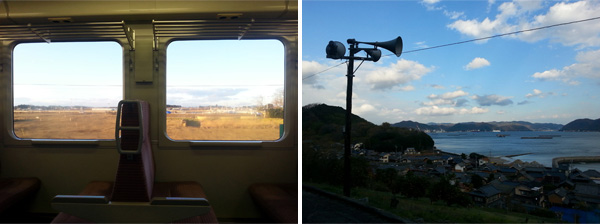
Left: Slow travel – on a road to Ishinomaki./ Right: Who’s speaking? – on Momoshima island.
Photo: Anna Ptak
Thanks to the AIT’s modes of thinking about residencies, I had the opportunity of moving outside the traditional formulae for artistic enquiry. Now, I can hardly wait for the arrival in Warsaw of four artists whom I met during my wanderings in Tokyo and beyond and invited in the firm conviction that plenty of work awaits in them in Poland. Any day now, Hiroharu Mori will be beginning his stay. His work moved me in its theatricalisation and rehearsal, both figuratively and literally, since he gave roles to fledging actors, of everyday kinds of speech and social roles. Mori is also a co-founder and director of the Artists’ Guild, a remarkable collective engaged in providing access to, and sharing, video and film equipment among artists and thus enabling the gradual attainment of independence from external funding.
Yet the technical solving of the problem of the need for equipment seems to be no more than the start of reflections on artists’ self-organisation of their work and one of the important themes of Mori’s residency will be his face to face encounter with the Polish experience in this area. And in a year’s time… for we hope we will succeed in obtaining all the essential funds… I am looking forward to seeing how Ujazdowski Castle and its idyllic park at the heart of the city are shaken up by the activities of the hyslom group. This trio of artists, one of whom is an architect, employ such intuition, curiosity and precision of action that the direct surroundings are released from the domination of limited and monofunctional use, becoming an area of discovery, ritual and freed energy. Skateboard-type power and dancing in the mud. Let’s do it!
★1──Gal Kirn: Artist in Residence Coming, Make Some Space, http://re-tooling-residencies.org/resources/research/artist-in-residence-coming-make-some-space-by-gal-kirn (retrieved on 18.02.2014)
★2──Pascal Gielen, The Murmuring of the Artistic Multitude: Global Art, Memory and Post-Fordism, Valiz, Amsterdam, 2009.
Anna Ptak
Born in 1979. Curator and art producer, with background in cultural anthropology. Since 2008 she is a curator at A-I-R Laboratory – a residency programme at the Centre for Contemporary Art Ujazdowski Castle in Warsaw, Poland. Within the frames of A-I-R Laboratory she has worked on multiple art productions and long term interdisciplinary art projects involving research on institutional and social conditions of art making, such as Studio Warsaw (2011/12) and Re-tooling Residencies (2010/2011). Ptak is also the editor of the reader accompanying the Re-tooling project. Currently she works on Re-Directing: East programme which searches for new communication channels in- between art practices in Eastern Europe and Middle East. As a curator she mainly deals with collaborative frameworks, i.e. she is interested in performative and collective aspects of audiovisual media and art in urban context. Project curated and produced (short selection):
– Wyspa. Now is Now:
http://www.alternativa.org.pl/title,Alternativa2012WyspaNowisNow,pid,86,oid,395,cid,370,type,17.html
– Filmworks Farm:
http://www.gospodarstwofilmowe.blogspot.com/
http://dizajnprojekt.pl/
– Neues Theater by Daniel Kötter:
http://www.danielkoetter.de/projekte/neues-theater
[April, 2014]
2024.7.9Acasă la Hundorf Residency JournalArtist : Miyake Suzuko
2023.5.14AIR and I, 09 : Mentoring Artists for Women’s Art (MAWA) Residence Report